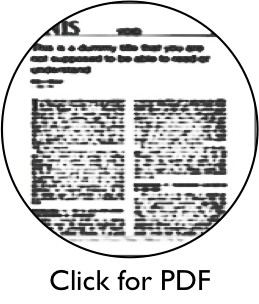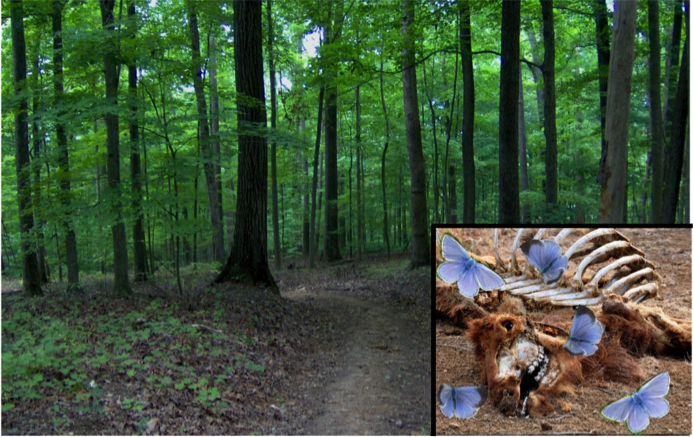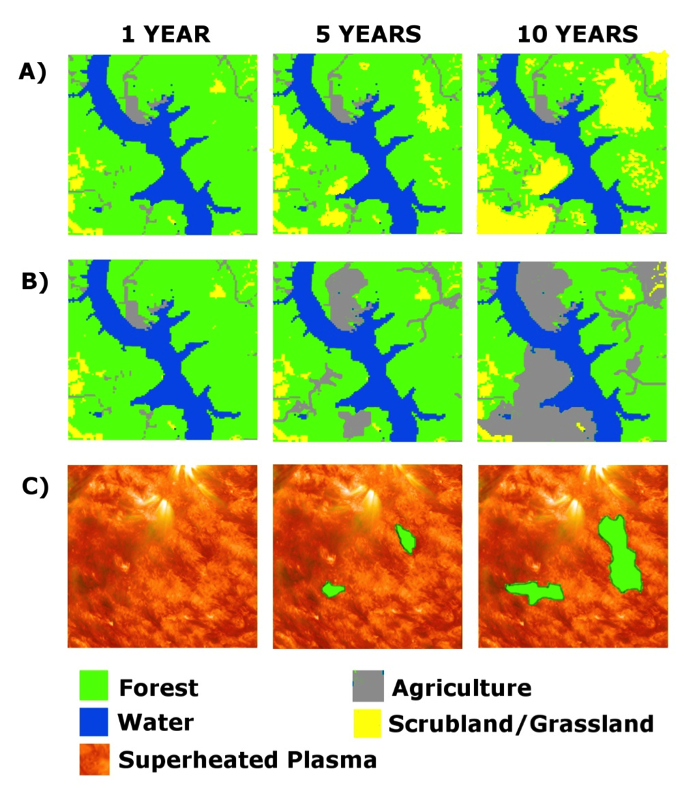
Tweet
September 19, 2014
Proceedings of the Natural Institute of Science | Volume 1 | SOFD 4
Effects of climate change, agricultural clearing, and the sun becoming a red giant on an old growth oak-hickory forest in southeastern Iowa
Foot F. Footman*1, Shoe F. Footman1
* - corresponding author: [email protected]
1 - Livingston Climatological Shackstitute, Livingston, TXsubmitted: September 9, 2014
accepted: September 12, 2014

Introduction
Many oak-hickory forests (Fig. 1) in southeastern Iowa are true “old growth” forests, with some stands remaining unburned and unlogged since the Ioway tribal presence in the region. These forests are critical conservation concerns, as they harbor approximately 2/5 of Iowa’s endemic flora and fauna, including the Midwest’s only venomous butterfly, the Blood-Toothed Skipper (Atrytone cruentumdentatum; Fig 1, inset). Annual ecosystem services of native oak-hickory forests in Iowa have been valued at more than $750 billion per acre (Corley 2006). However, despite their immense value, more than 98% of native Iowan forests have been lost in the last 60 years. Future losses of forested area are also expected despite ongoing conservation efforts. Here, we use a predictive model to simulate changes in forested area for a 100 km2 area in Johnson County in the face of its three primary threats: a) human-induced climate change, b) agricultural encroachment, and c) immolation of the Earth by the Sun during its progression into a red giant stage. We pay particular attention to predicted impacts on blood-toothed skippers.

Methods
We used an Earth-system Model of Amazing Complexity (EMAC; Simpkins and Eiderdown, 2013) capable of incorporating each of the three model variants with only minor adjustments. Simulations were derived by hand and photocopies of the code are available from the authors for a considerable fee.
For the climate change model, we simulated temperature increases of 0.4°C per decade, commensurate with current predictions for the Midwestern United States. While other estimates have been proposed – including the suggestion that climate change is not happening at all – we decided on the 0.4°C value because it was developed using “science”, a method used to learn verifiable truths about the natural world in a manner independent of superstition, economic/political interests, or appeals to the supernatural.
We simulated agricultural encroachment at three scales of intensity: 5, 10, and 15 acres per year. We imagined that the simulated agriculture consisted of a diverse assortment of sustainable crops and livestock intended exclusively for local consumption because, fuck you, it doesn’t matter to the model what the land is used for and killing every living thing in sight for the sake of corn syrup and slightly cheaper gasoline makes us want to fucking kill ourselves.
Our red giant model simulated engulfment of the Earth by the sun, resulting in increases of mean daytime temperatures to 5000K, a superheated plasma atmosphere, a helium flash stage, and a 1.7% initial increase in soil nitrate.
Results and Discussion
Climate change models predict a slight loss of total forested area over the 15 year period (Fig 2A). Most forest was replaced by a mixed shrubland-grassland. Impacts on skippers are likely to be minimal, as native grasses are valuable components of the headdresses used in the overly-involved skipper mating rituals.

Agricultural encroachment models predicted losses of forested area at a similar magnitude to climate change models. At extremely fine spatial scales, families could be seen enjoying fresh broccoli, Brussels sprouts, kale, artisanal raw cheeses, and a regional beef and pork hash (Fig. 3; regional beef and pork hash not pictured). A low-alcohol Kvass, flavored with wild mint and paw paw, was a big hit across all age groups.

In the simulation involving a solar progression into red giant stage, oak-hickory forests were reduced to their elemental constituents and redistributed among the cosmos. Based on previous experimental work (Footman and Footman, 1987), these conditions are likely to be initially unfit for local persistence of the blood-toothed skipper, which has a sizeable home range and requires its oak-hickory habitat to exist in an incorporated form. Interestingly, our simulation showed some regrowth of forest after 5 years, and 9.7% regrowth after 10 years. Most regrowth was asbestos pine, a species usually only found in oak-hickory stands at low densities but which is a strong fire-successional that becomes dominant in forests only under extreme habitats unwelcoming to all other life (Grordon, 2013).
On balance, we conclude that immolation by a red giant sun will have the least dramatic long-term impact of three potential threats to native Iowa forest diversity. At the 15 year mark, forests continued to dwindle in size in the face of climate change and agricultural encroachment, while forests in the red giant model had begun to rebound. Further, asbestos pine has been touted as an adequate replacement for native oak-hickory, as it has equal value to the Eastern Iowa woodworking community (Green 2003), and can support large populations of elk, the primary food source for endemic blood-toothed skippers (Adams 1832). To promote the best possible outcome for oak-hickory forests, we therefore recommend sending a massive stellar bomb into the sun to induce an early evolution to its red giant stage (e.g., Boyle, 2007). We do not recommend turning it into a slasher movie in the third act.
References
Adams, A. 1832. Notes on a new species of pestilent Flutter-by of the Cedar and Ioway river valleys. McRandall’s Almanack. 13: 24.
Boyle, D. 2007. Sunshine. Fox Searchlight Pictures. 107 min.
Corley, M. 2006. Presidential address, Society of Brain-Damaged Economists.
Footman, F. F. and S. F. Footman. 1987. Effects of landscape fragmentation and temperatures in excess of 4000K on predation of elk by blood-toothed skippers. Elk Fancy. 36: 1-257.
Green, S. 2003. Any Wood’ll Do! Uncirculated Pamphlet.
Grordon, G. 2013. Rapid invasion of Asbestos pine in downtown Gary, Indiana. Urban Invasives. 222: 12-31.
Simpkins, O. and P. Eiderdown. 2013. Climate models for Generation neXt. Maths. 14:450-470.

Proceedings of the Natural Institute of Science (PNIS) by https://instsci.org/ is licensed under a Creative Commons Attribution-ShareAlike 4.0 International License.